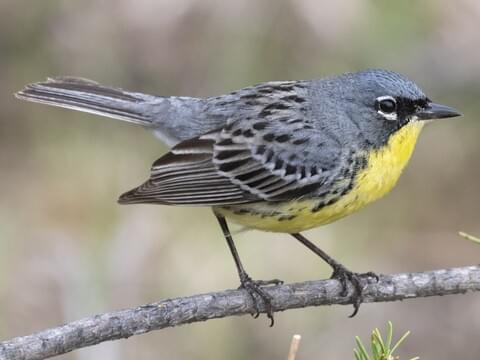
The 18 most-wanted birds in North America
Kirtland’s Warbler
1. The only eastern warbler that John James Audubon never saw was Kirtland’s Warbler. 2. He died in January 1851; the bird was discovered four months later, when a specimen was collected in Ohio on the property of Dr. Jared P. Kirtland, a physician and respected naturalist. 3. That the warbler was named for Dr. Kirtland probably irked Dr. Samuel Cabot; he had collected the first specimen in 1841 on a ship near the Bahamas, but no one knew about it until after the bird had been named. 4. In any event, the bird was largely a mystery for the remainder of the 1800s. Its breeding range in large jack pine stands in Michigan would not be found until 1903. 5. Over the last century, ornithologists have theorized that the warbler’s migration route was a fairly narrow band between Michigan and the Bahamas, that the bird followed river valleys, and that it makes the 1,380-mile flight north with few or no stops. 6. Research published just this year in North American Birds suggests none of this is true. More than a century’s worth of sightings, the authors say, show that after warblers cross the ocean from the Bahamas, they fan out. The most common stopover habitat is a shrub/scrub mix — similar to optimal breeding habitat. 7. What’s more, like every other warbler you’ve ever watched, Kirtland’s Warbler does indeed stop to feed on insects during its migration. 8. The authors also note that the core breeding area in Michigan is “almost due magnetic north of the center of the species’ wintering grounds in the Bahamas.” This may explain why the warbler chooses to nest in a fairly narrow region and not in the much wider band of jack pine across the continent. 9. When glaciers covered much of North America in the last ice age, jack pines occurred only along the Atlantic coast and in the Appalachian highlands. Consequently, the bird almost certainly didn’t nest in Michigan. 10. Ornithologist Harold Mayfield, a Kirtland’s Warbler expert, believed that the bird’s breeding range “may have been restricted to the sandy coastal plain of the south Atlantic states.”
1. The only eastern warbler that John James Audubon never saw was Kirtland’s Warbler. 2. He died in January 1851; the bird was discovered four months later, when a specimen was collected in Ohio on the property of Dr. Jared P. Kirtland, a physician and respected naturalist. 3. That the warbler was named for Dr. Kirtland probably irked Dr. Samuel Cabot; he had collected the first specimen in 1841 on a ship near the Bahamas, but no one knew about it until after the bird had been named. 4. In any event, the bird was largely a mystery for the remainder of the 1800s. Its breeding range in large jack pine stands in Michigan would not be found until 1903. 5. Over the last century, ornithologists have theorized that the warbler’s migration route was a fairly narrow band between Michigan and the Bahamas, that the bird followed river valleys, and that it makes the 1,380-mile flight north with few or no stops. 6. Research published just this year in North American Birds suggests none of this is true. More than a century’s worth of sightings, the authors say, show that after warblers cross the ocean from the Bahamas, they fan out. The most common stopover habitat is a shrub/scrub mix — similar to optimal breeding habitat. 7. What’s more, like every other warbler you’ve ever watched, Kirtland’s Warbler does indeed stop to feed on insects during its migration. 8. The authors also note that the core breeding area in Michigan is “almost due magnetic north of the center of the species’ wintering grounds in the Bahamas.” This may explain why the warbler chooses to nest in a fairly narrow region and not in the much wider band of jack pine across the continent. 9. When glaciers covered much of North America in the last ice age, jack pines occurred only along the Atlantic coast and in the Appalachian highlands. Consequently, the bird almost certainly didn’t nest in Michigan. 10. Ornithologist Harold Mayfield, a Kirtland’s Warbler expert, believed that the bird’s breeding range “may have been restricted to the sandy coastal plain of the south Atlantic states.”
Advertisements
11 June 2022
Advertisements



